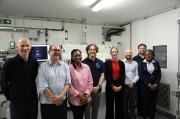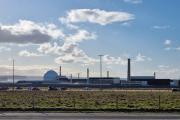Dounreay Bulletin - Issue 7
25th July 2006
DOUNREAY DIRECTOR TAKES TEMPORARY CHARGE OF UKAEA
Following Dipesh Shah's decision not to seek a further term as chief executive of the UKAEA when his current three-year term ends in November, Norman Harrison, currently the director at Dounreay, has been appointed acting chief operating officer of the UKAEA. While Dipesh Shah will remain as CEO for the balance of his appointment, Norman Harrison's role as acting chief operating officer will ensure continuity in the day-to-day running and performance of the organisation until a new CEO is appointed. To ensure continuity at Dounreay, Simon Middlemas, currently site manager, has been appointed acting director.
REPORT SETS OUT YEAR OF PROGRESS TO DECOMMISSION DOUNREAY
The first annual report on progress to decommission the former experimental reactor site at Dounreay has been published today. Dounreay Review 2005/06 has been produced by UKAEA, the body carrying out the safe clean-up and dismantling of the 140-hectare site.
Its publication covers the 12-month period since April 1, 2005, when UKAEA's clean-up role changed to that of a contractor to the new Nuclear Decommissioning Authority. The report outlines the key decommissioning achievements during the year as well as safety, environmental and financial indicators, and summarises the performance-based incentives that are used by the NDA to measure delivery and award fee.
The report can be downloaded at http://www.ukaea.org.uk/downloads/dounreay/Dounreay_Review_2005-06.pdf
Hard copies are available on request from the communications department at Dounreay (tel: 01847 806080).
NEW PLANT STARTS FOR NEXT PHASE OF SODIUM CLEAN-UP
The sodium inventory disposal (SID) facility has commenced active commissioning at the Prototype Fast Reactor (PFR). This symbolises a major step forward, as it allows UKAEA to start removing the final traces of sodium from redundant plant equipment being stored at PFR.
The pioneering facility, constructed within the sodium tank farm, uses the water vapour nitrogen process developed at the Janetstown off-site test facility to remove tritiated alkali metal residues from plant and vessels made redundant by decommissioning work on the Dounreay site. The facility has been designed, built and safely commissioned for UKAEA by the Alkali Metal Residue Recovery (AMRR) alliance of companies.
The new plant is currently being used to clean the reaction vessel from the thermal stripping rig, which was part of D8530 and was decommissioned in 1999. Operation of the new facility will allow vessels and components currently stored at PFR to be cleaned, allowing decommissioning of these systems to progress in the near future. The facility has also been designed to allow future modification to clean items wetted with the sodium-potassium metal used in the DFR, and the four remaining tanks within the sodium tank farm - all key parts of the site's future clean-up plan.
PFR POND CLEAN-UP COMMENCED
For the first time since the Prototype Fast Reactor commenced operation in 1974, the removal of items from the buffer store pond has commenced.
In the early 1980s two trial irradiated sub assemblies were placed in the pond as corrosion experiments to assess the corrosion effects of water on fuel. They were placed in modified spent fuel cans, with holes top and bottom, which allowed water to flow through the cans while the pond water was sampled for activity. With routine monitoring it was known early in the experiment that activity was present in the water, and in the mid-90s, due to the corrosion trial, the activity level in the pond water was steadily rising and continued to do so until the pond clean-up plant was commissioned last year. The revolutionary removal project began over five years ago, with the preparation of safety assessments.
More: http://www.ukaea.org.uk/sites/dounreay_project_updates.htm#July0602
On July 1, an unplanned discharge of krypton 85 gas occurred as a result of this work. While unplanned, the emission did not breach the discharge authorisation for PFR decommissioning and amounted to less then one per cent of the site's discharge authorisation for krypton 85. Regulators were notified and an internal investigation started.
UKAEA LISTENS TO PUBLIC VIEWS ON PARTICLES
An independent report on the views of people in Caithness and north Sutherland about radioactive particles in the marine environment has been published. The report summarises the feedback from more than 400 people who took part in a series of information-gathering events ahead of formal consultation later this year on the options for dealing with the particles. UKAEA's response to the views has also been published.
More: http://www.ukaea.org.uk/news/2006/11_07_06.html
Meanwhile, work is underway to begin a technical assessment of the options. A scoring panel has been set up and meets this week for the first time. The group consists of independent members representing a wide range of expertise, including environment, health and safety, socio-economics and marine engineering. They will initially screen out options which are not technically feasible or are illegal, then assess the options left against a set of criteria. Once that is done work will begin combining on-shore and off-shore options before carrying out final scoring. All information will be made available and there will be full consultation to determine the best practical environmental option (BPEO).
DUNNET BEACH CLEAN
Staff from Dounreay took time out to undertake a beach clean at Dunnet. Forty-one volunteers and their families struck it lucky with a beautiful sunny day and worked from 1pm to 5pm, collecting over 250 bags of rubbish from the beach. The clean-up was organised by the site after a follow-up particle survey found nothing. Simon Middlemas, acting Dounreay director, said: "I was pleased when it was reported that no particles had been detected following the second survey of the beach. Dunnet is a beautiful beach and a beach clean was just what it needed to allow people to enjoy the beach to the full - especially with the weather being so good."
MEP SEES INSIDE REACTOR DECOMMISSIONING
Struan Stevenson, a Scottish Conservative Member of Parliament, made a fact-finding visit to Dounreay on July 19. He met with senior management, trade union representatives and saw inside the decommissioning of the Dounreay Fast Reactor.
BOARD HOSTS RECEPTION
The board of the UKAEA met at Dounreay on July 3. The preceding evening, members hosted a reception at the Park Hotel, Thurso, attended by over 100 figures from the local community.
AT A GLANCE
Number of days since a lost time accident - 33 days
(No. of man-hours since a lost time accident - 454,279 hours)
Liquid metal destroyed in decommissioning Prototype Fast Reactor
Volume: 1136 tonnes
Percentage complete: 75 %
NB Plant currently shut down while major reactor components are jacked up out of their seal.
Research reactor reprocessing liquor conditioned as solid intermediate-level waste
Total no. of drums to date: 1,879
Percentage complete to date: 37.6%
Conditioned in current financial year: 0
NB Plant currently shut down while spillage is cleaned up.
Solid Low Level Waste processed for disposal
Total so far this financial year: 2,101 drums
Employment levels
UKAEA - Full Time Equivalents
May 1,173
June 1,160
July 1,144
Sub-contractors - number of personal passes
1,220
1,206
1,198
Sub-contractors - number of gate-held passes
232
179
180
Related Businesses
Related Articles
UKAEA develops 3D printing for fusion components
At its recently opened Central Support Facility (CSF), UKAEA has commissioned an electron beam additive manufacturing machine that can be used to incorporate tungsten into components, alongside a selective laser manufacturing machine. Fusion can play a key role in a global low carbon energy future.Advancing Fusion Remote Maintenance: Industry Collaboration Driving Innovation
As part of the Fusion Futures (FF) programme, UKAEA's Remote Applications in Challenging Environments (RACE) has partnered with industry leaders to develop two groundbreaking technologies for remote maintenance in fusion energy engineering. Thanks to FF funding, industry has taken the lead in maturing UKAEA technology concepts—delivering real-world solutions that enhance operational autonomy and reduce maintenance burdens in extreme environments.UKAEA launches International Fellowships Scheme for fusion
UKAEA has launched the International Fellowships Scheme, an initiative to help expand the global talent pool supporting the fusion industry. The scheme is part of the UKAEA's Fusion Opportunities in Skills, Training, Education and Research (FOSTER) Programme, which aims to train, support, and empower the next generation of professionals, who will help deliver fusion power to the grid.Kyoto Fusioneering and Astral Systems join Culham fusion hub
UKAEA's Culham Campus welcomes Kyoto Fusioneering and Astral Systems as its latest tenants. Two pioneering companies, Kyoto Fusioneering and Astral Systems, have joined the growing cluster of fusion technology and AI organisations at United Kingdom Atomic Energy Authority's (UKAEA) Culham Campus.
Fusion-grade Steel Produced At Scale In UK-first
Researchers achieve 10x production cost savings for reduced activation steel. A United Kingdom Atomic Energy Authority (UKAEA) working group has successfully demonstrated the industrial scale production of fusion-grade steel.
UKAEA To Lead The Creation Of A Robotics And AI Cluster
UKAEA will lead the creation of a new £4.9m nuclear robotics and artificial intelligence cluster across Cumbria and Oxfordshire. The robotics and AI cluster was announced by UK Research and Innovation (UKRI) as one of seven new projects to kickstart economic growth and address regional needs: www.ukri.org The robotics and AI cluster will link Cumbria and Oxfordshire to accelerate the decommissioning of the UK's legacy nuclear fission facilities and keep people out of hazardous environments.
Diamonds Are Forever? World-first Carbon-14 Diamond Battery Made In Uk
The world's first carbon-14 diamond has been produced with the potential to provide power for thousands of years. Scientists and engineers from the UK Atomic Energy Authority (UKAEA) and the University of Bristol have successfully created the world's first carbon-14 diamond battery.
UKAEA Monthly Newsletter Latest Edition
Find out what has been happening at UKAEA in our monthly newsletter. Read about our recent activities and upcoming events.
UKAEA Newsletter - Edition 11 Published Today
Find out what has been happening at UKAEA in our monthly newsletter. Read about our recent activities and upcoming events.
Corwm Visits Dounreay Nuclear Site
Members were given an overview of the scale of the problem and challenges faced in the decommissioning of the site. In the last week of March 2024, several members of CoRWM led by the Chair, Sir Nigel Thrift, made the long journey up to the North of Scotland to visit the Dounreay nuclear site, now managed by Nuclear Restoration Services.
